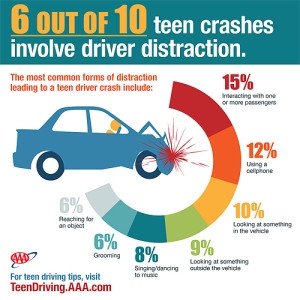 According to a report by the AAA Foundation Research – they studied Environmental Factors and Driver Behaviors in Teen Driver Crashes and the following is a summary of their report.
According to a report by the AAA Foundation Research – they studied Environmental Factors and Driver Behaviors in Teen Driver Crashes and the following is a summary of their report.
The Situation
• 963,000 drivers ages 16-19 were involved in police-reported motor vehicle crashes in 2013, which resulted in 383,000 injuries and 2,865 deaths.
• Understanding the causes and contributing factors of teen driver crashes is necessary to develop effective solutions to reduce teen driver crash risk.
• Most teen driver crash studies have relied on data derived from police reports. Some key information about crashes, e.g., the driver’s behaviors and actions immediately prior to the crash, is difficult for police to ascertain after the fact, thus some key factors may be systematically under-reported in the national statistics.
• Previous studies using in-vehicle video cameras have observed only small
numbers of moderate-to-severe crashes, very few involving teens.
Overview
Researchers at the University of Iowa examined data from teen driver crashes captured on the Ltyx DriveCam in-vehicle video camera system.
• Drivers were ages 16-19 and were participating in a program using a DriveCam. Most lived in the Midwest region of the United States.
• Crashes occurred between August 2007 and July 2013.
• Results are based on examination of 1,691 eligible crashes.
• Video was examined for the 6 seconds preceding each crash.
• Major crash types examined were single-vehicle loss of control, single-vehicle road departure, rear-end, and angle (front-to-side).
Key Findings
The driver was found to have been driving too fast for conditions in 79% of single-vehicle crashes; following too closely in 36% of rear-end crashes, and failed to yield to another vehicle in 43% of angle crashes.
The driver was inattentive or engaged in some other non-driving-related activity in 58% of crashes overall (44% of loss-of-control crashes, 89%of road-departure crashes, 76% of rear-end crashes, and 51% of angle crashes).
The most frequent potentially-distracting behaviors were conversing or otherwise interacting with passengers and cell phone use.
• Passengers were present in 36% of all crashes – 84% of passengers were estimated to be ages 16-19; fewer than 5% were parents or other adults. Driver was conversing or otherwise interacting with passenger in 15% of crashes.
• The driver was engaged in cell phone use in 12% of crashes
• Visibly using a cell phone in 8% of all crashes;
• Cell phone use appeared likely (driver looking at or manipulating something out of view of the camera) in an additional 4%.
Cell phone use varied significantly by crash type:
• Visible in 21% of road-departure crashes, not visible but likely in additional 13%
• Visible in 10% of rear-end crashes, not visible but likely in additional 8%
• Least prevalent in single-vehicle loss-of-control crashes (most of these involved adverse weather or surface conditions).
Drivers operating or looking at cell phones looked away from the forward roadway excessively – spent an average of 4.1 seconds out of final 6 seconds before the crash looking away.
The driver exhibited no reaction at all before impact in over half of rear-end crashes involving cell phone use.
Decision errors such as failing to yield right of way, running stop signs and driving too fast, were involved in 66% of crashes.
Implications
• Distraction due to cell phone use appears to be much more prevalent than is reflected in official government statistics derived from police reports.
• Official statistics from the National Highway Traffic Safety Administration indicate that 14% of all crashes involve driver distraction, with 7% of those (1% of all crashes) involving distraction related to cell phone use.
• Driver education and training should teach young drivers to avoid taking excessively long glances away from the forward road way.
Useful Resources
AAA and the AAA Foundation have developed several resources for families with teen drivers:
• Driver‐ZED – Interactive risk‐management training tool designed to help teens recognize how to react in a variety of driving scenarios.
• StartSmart Online Parent Session – Two-hour webinar that explains the licensing process and parents’ role, and demonstrates how to reinforce what your teen is learning in DE and how to maximize the practice driving that you’ll do with your teen.
• TeenDriving.AAA.com – AAA site that provides state ‐ specific information to help parents and their teens navigate the learning‐to‐drive process, and includes links to the above programs.
For more information about the AAA Foundation’s teen safety research, please visit www.AAAFoundation.org
Search TeenAuto
Socialize with Us
Like us on FacebookFollow us on TwitterWatch our Channel